DM-MQTT: An Efficient MQTT Based on SDN Multicast for Massive IoT Communications
Abstract
:1. Introduction
2. Related Works
3. Materials and Methods
3.1. Architecture Overview
3.2. DM-MQTT Operation Process
3.3. Direct Multicast—MQTT
- Publisher IP address
- The IP address of the slave broker connected with the publisher
- Subscriber IP address
- The IP address of the slave broker connected with the subscriber
- Topic
- Emergency data flag
- QoS level
- Subscribers in h6 and h9 forward connection messages that subscribe topic alpha to slave brokers in their existing edge network
- Slave brokers h2 and h3 send edge information, including subscription information, to master broker h10
- The master broker sends subscriber edge information to the SDN controller C0
- The publisher in h5 sets topic alpha as an emergency message and sends a connection message to slave broker h1
- The slave broker h1 sends the edge information including the topic alpha publications to the master broker
- The master broker sends publisher edge information to the SDN controller
- The SDN controller creates a multicast group to make a flow entry and sends a flow-mode message to the S4, S5, S6, S7, S8, and S9 switches
- The SDN controller sends a bandwidth reservation on the topic alpha to switches
- Data published from h5 is sent to h6 and h9 according to flow entry
4. Results and Discussion
4.1. The Experimetal Environments
4.2. The Data Transfer Delay Performance of DM-MQTT
4.3. The Network Usage of DM-MQTT
5. Conclusions
Author Contributions
Funding
Conflicts of Interest
References
- Evans, D. The Internet of Things: How the next evolution of the Internet is changing everything. CISCO White Pap. 2011, 1, 1–11. [Google Scholar]
- Greenberg, A.; Hamilton, J.; Maltz, D.A.; Patel, P. The cost of a cloud: Research problems in data center networks. ACM SIGCOMM Comput. Commun. Rev. 2008, 39, 68–73. [Google Scholar]
- Taleb, T.; Dutta, S.; Ksentini, A.; Iqbal, M.; Flinck, H. Mobile edge computing potential in making cities smarter. IEEE Commun. Mag. 2017, 55, 38–43. [Google Scholar]
- Self-Driving Cars Will Create 2 Petabytes of Data, What Are the Big Data Opportunities for the Car Industry. Available online: http://www.computerworlduk.com/news/data/boeing-787screate-half-terabyte-of-data-per-flight-says-virgin-atlantic-3433595/ (accessed on 7 December 2016).
- Data Never Sleeps 2.0. Available online: https://www.domo.com/blog/2014/04/data-never-sleeps-2-0/ (accessed on 7 December 2016).
- Popa, L.; Kumar, G.; Chowdhury, M.; Krishnamurthy, A.; Ratnasamy, S.; Stoica, I. FairCloud: Sharing the network in cloud computing. ACM SIGCOMM Comput. Commun. Rev. 2012, 42, 187–198. [Google Scholar]
- Rahmani, A.M.; Gia, T.N.; Negash, B.; Anzanpour, A.; Azimi, I.; Jiang, M.; Liljeberg, P. Exploiting smart e-Health gateways at the edge of healthcare Internet-of-Things: A fog computing approach. Futur. Gener. Comput. Syst. 2018, 78, 641–658. [Google Scholar]
- Roca, D.; Milito, R.; Nemirovsky, M.; Valero, M. Tackling IoT Ultra Large Scale Systems: Fog computing in support of hierarchical emergent behaviors. In Fog Computing in the Internet of Things; Springer: Cham, Switzerland, 2018; pp. 33–48. [Google Scholar]
- Aazam, M.; Huh, E.N. Fog computing micro datacenter based dynamic resource estimation and pricing model for IoT. In Proceedings of the 2015 IEEE 29th International Conference on Advanced Information Networking and Applications, Gwangju, Korea, 25–27 March 2015; pp. 687–694. [Google Scholar]
- Weisong, S.; Cao, J.; Zhang, Q.; Li, Y.; Xu, L. Edge computing: Vision and challenges. IEEE Internet Things J. 2016, 3, 637–646. [Google Scholar]
- Xiang, S.; Ansari, N. EdgeIoT: Mobile edge computing for the Internet of Things. IEEE Commun. Mag. 2016, 54, 22–29. [Google Scholar]
- Al-Fuqaha, A.; Guizani, M. Internet of things: A survey on enabling technologies, protocols, and applications. IEEE Commun. Surv. Tutor. 2015, 17, 2347–2376. [Google Scholar]
- Govindan, K.; Azad, A.P. End-to-end service assurance in IoT MQTT-SN. In Proceedings of the 2015 12th Annual IEEE Consumer Communications and Networking Conference (CCNC), Las Vegas, NV, USA, 9–12 January 2015; IEEE: Piscataway, NJ, USA, 2015; pp. 290–296. [Google Scholar]
- Roy, D.G.; Mahato, B.; De, D.; Buyya, R. Application-aware end-to-end delay and message loss estimation in Internet of Things (IoT)—MQTT-SN protocols. Future Gener. Comput. Syst. 2018, 89, 300–316. [Google Scholar]
- McKeown, N. Software-defined networking. In Proceedings of the INFOCOM Keynote Talk, Rio de Janeiro, Brazil, 19–25 April 2009; pp. 30–32. [Google Scholar]
- Bertaux, L.; Hakiri, A.; Medjiah, S.; Berthou, P.; Abdellatif, S. A DDS/SDN based communication system for efficient support of dynamic distributed real-time applications. In Proceedings of the 2014 IEEE/ACM 18th International Symposium on Distributed Simulation and Real Time Application, Toulouse, France, 1–3 October 2014; IEEE: Piscataway, NJ, USA, 2014; pp. 77–84. [Google Scholar]
- Choi, H.Y.; King, A.L.; Lee, I. Making DDS really real-time with OpenFlow. In Proceedings of the 13th International Conference on Embedded Software, Pittsburgh, PA, USA, 1–7 October 2016; ACM: New York, NY, USA, 2016; p. 4. [Google Scholar]
- Huh, J.H.; Kim, D.H.; Kim, J.D. oneM2M: Extension of protocol binding: Reuse of binding protocol’s legacy services. In Proceedings of the 2016 International Conference on Information Networking (ICOIN), Kota Kinabalu, Malaysia, 13–15 January 2016; IEEE: Piscataway, NJ, USA, 2016; pp. 363–365. [Google Scholar]
- Bormann, C.; Castellani, A.P.; Shelby, Z. Coap: An application protocol for billions of tiny internet nodes. IEEE Internet Comput. 2012, 16, 62–67. [Google Scholar]
- Schütz, B.; Bauer, J.; Aschenbruck, N. Improving Energy Efficiency of MQTT-SN in Lossy Environments Using Seed-Based Network Coding. In Proceedings of the 2017 IEEE 42nd Conference on Local Computer Networks (LCN), Singapore, 9–12 October 2017; IEEE: Piscataway, NJ, USA, 2016; pp. 286–293. [Google Scholar]
- Amaran, M.H.; Noh, N.A.M.; Rohmad, M.S.; Hashim, H. A comparison of lightweight communication protocols in robotic applications. Procedia Comput. Sci. 2015, 76, 400–405. [Google Scholar]
- Stanford-Clark, A.; Truong, H.L. MQTT for Sensor Networks (MQTT-SN) Protocol Specification; Version 1.2; International Business Machines (IBM): Armonk, NY, USA, 2013. [Google Scholar]
- Kim, J.; Choi, S.C.; Yun, J.; Lee, J.W. Towards the oneM2M Standards for Building IoT Ecosystem: Analysis, Implementation and Lessons. Peer-to-Peer Networking and Applications; Springer: Cham, Switzerland, 2018; pp. 139–151. [Google Scholar]
- Xu, Y.; Mahendran, V.; Radhakrishnan, S. Towards SDN-based fog computing: MQTT broker virtualization for effective and reliable delivery. In Proceedings of the 2016 8th Communication Systems and Networks (COMSNETS), Bangalore, India, 5–10 January 2016; IEEE: Piscataway, NJ, USA, 2016; pp. 1–6. [Google Scholar]
- Park, J.H.; Yun, S.; Kim, H.; Kim, W.T. Emergent-MQTT over SDN. In Proceedings of the 2017 International Conference on Information and Communication Technology Convergence (ICTC), Jeju, South Korea, 18–20 October 2017; IEEE: Piscataway, NJ, USA, 2017; pp. 882–884. [Google Scholar]
- Park, J.H. Dependable fire detection system with multifunctional artificial intelligence framework. IEEE Netw. under review.
- Banno, R.; Sun, J.; Fujita, M.; Takeuchi, S.; Shudo, K. Dissemination of edge-heavy data on heterogeneous MQTT brokers. In Proceedings of the 2017 IEEE 6th International Conference Cloud Networking (CloudNet), Prague, Czech Republic, 25–27 September 2017; IEEE: Piscataway, NJ, USA, 2017; pp. 1–7. [Google Scholar]
- Lin, Y.-D.; Lai, Y.-C.; Teng, H.Y.Y.; Liao, C.C.C.; Kao, Y.C. Scalable multicasting with multiple shared trees in software defined networking. J. Netw. Comput. Appl. 2017, 78, 125–133. [Google Scholar]
- Braun, W.; Menth, M. Software-defined networking using openflow: Protocols, applications and architectural design choices. Future Internet 2014, 6, 302–336. [Google Scholar]
- Kim, H.; Yun, S.; Kim, H.; Kim, W.T. A novel SDN multicast for large-scale IoT environments. In Proceedings of the 2017 International Conference on Information and Communication Technology Convergence (ICTC), Jeju, South Korea, 18–20 October 2017; IEEE: Piscataway, NJ, USA, 2017; pp. 823–828. [Google Scholar]
- De Oilveira, R.L.S.; Shinoda, A.A.A.; Schweitzer, C.M.M.; Prete, L.R. Using Mininet for emulation and prototyping Software-Defined Networks. In Proceedings of the 2014 IEEE Colombian Conference on Communications and Computing (COLCOM), Bogota, Colombia, 4–6 June 2014; IEEE: Piscataway, NJ, USA, 2014; pp. 1–6. [Google Scholar]
- Oktian, Y.E.; Lee, S.G.; Lee, H.J. Distributed SDN controller system: A survey on design choice. Comput. Netw. 2017, 121, 100–111. [Google Scholar]
- OpenFlow Switch Specification, Version 1.5.1; Open Networking Foundation (ONF): Menalo Park, CA, USA, 2015.
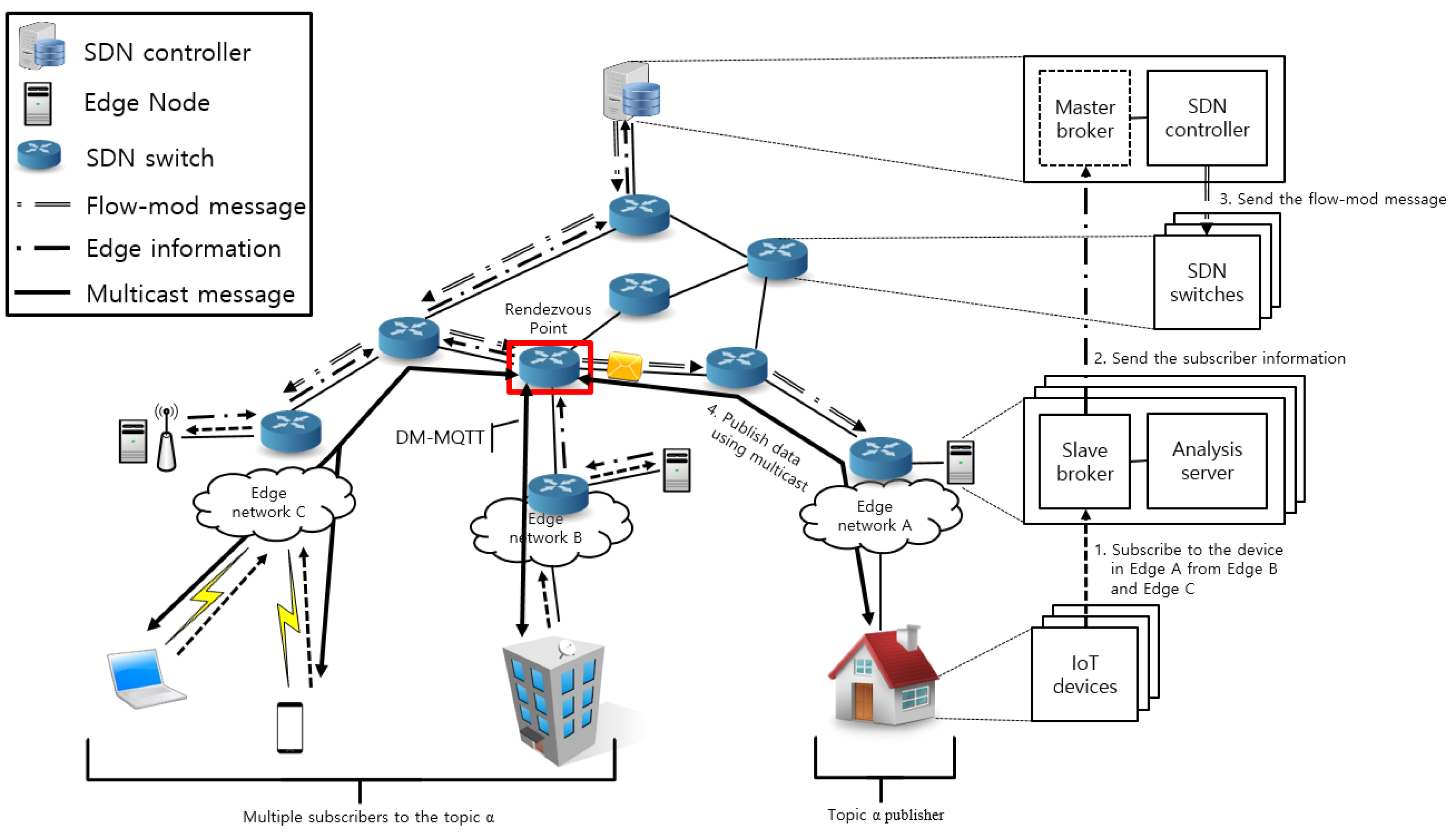
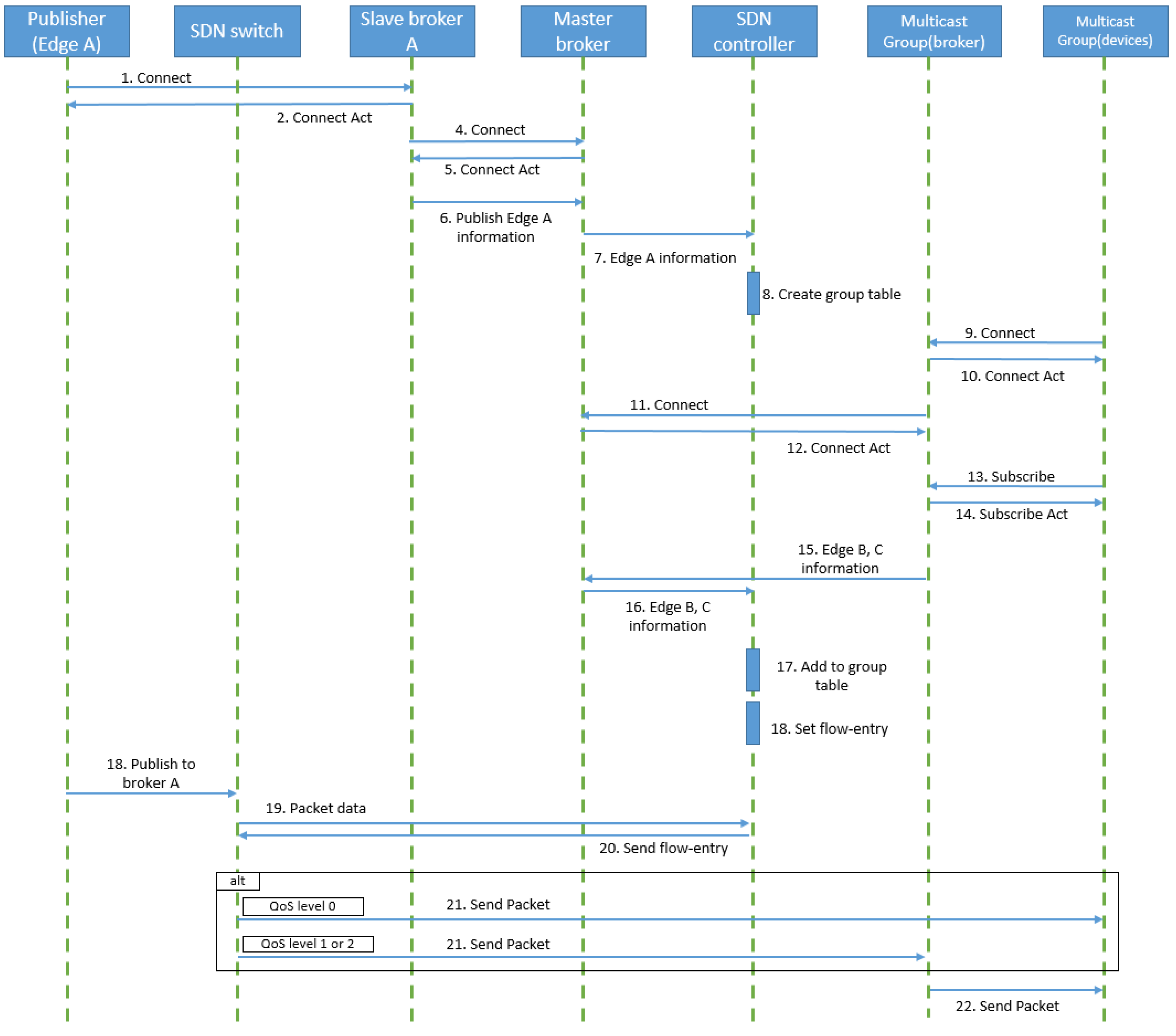
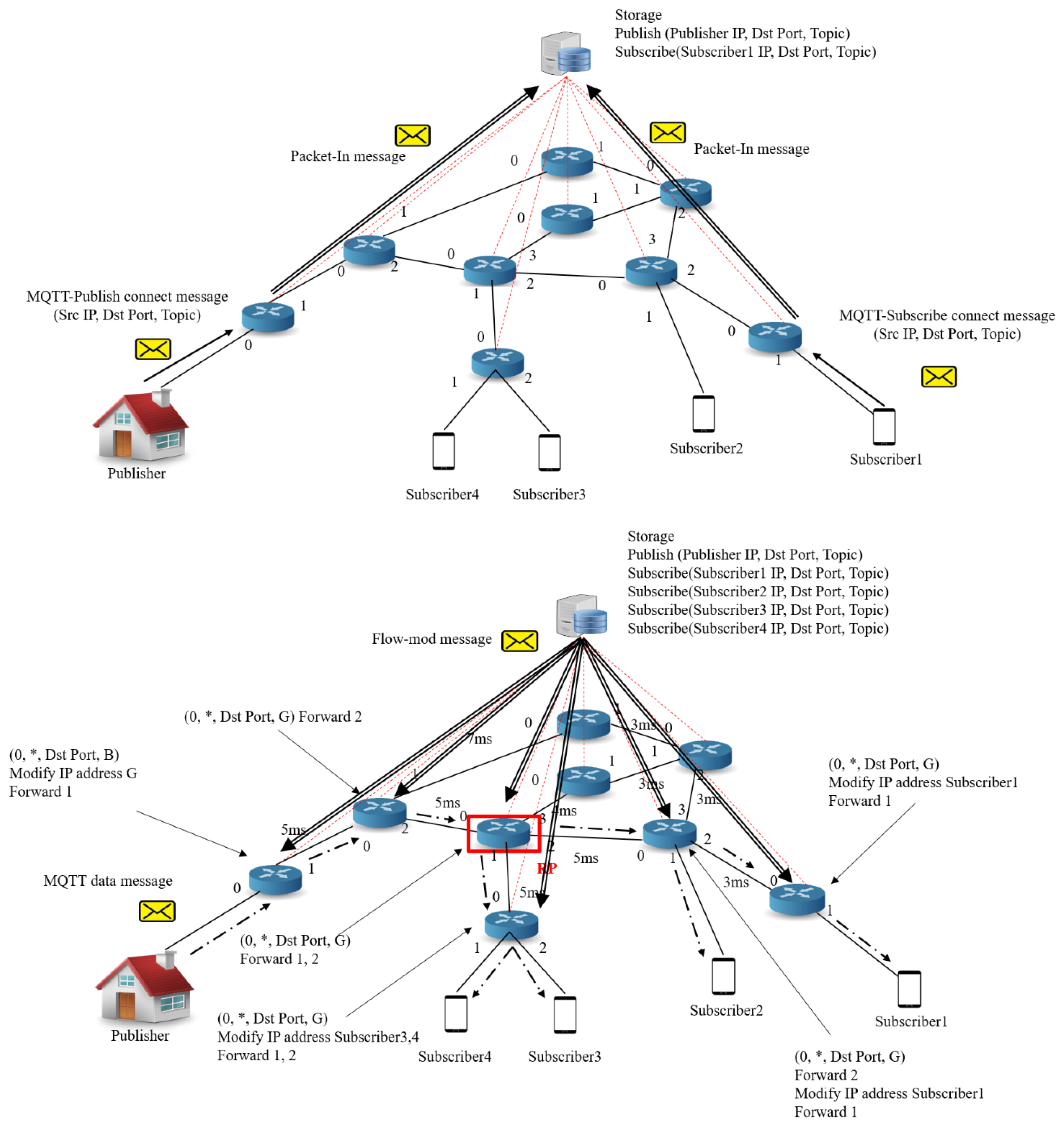
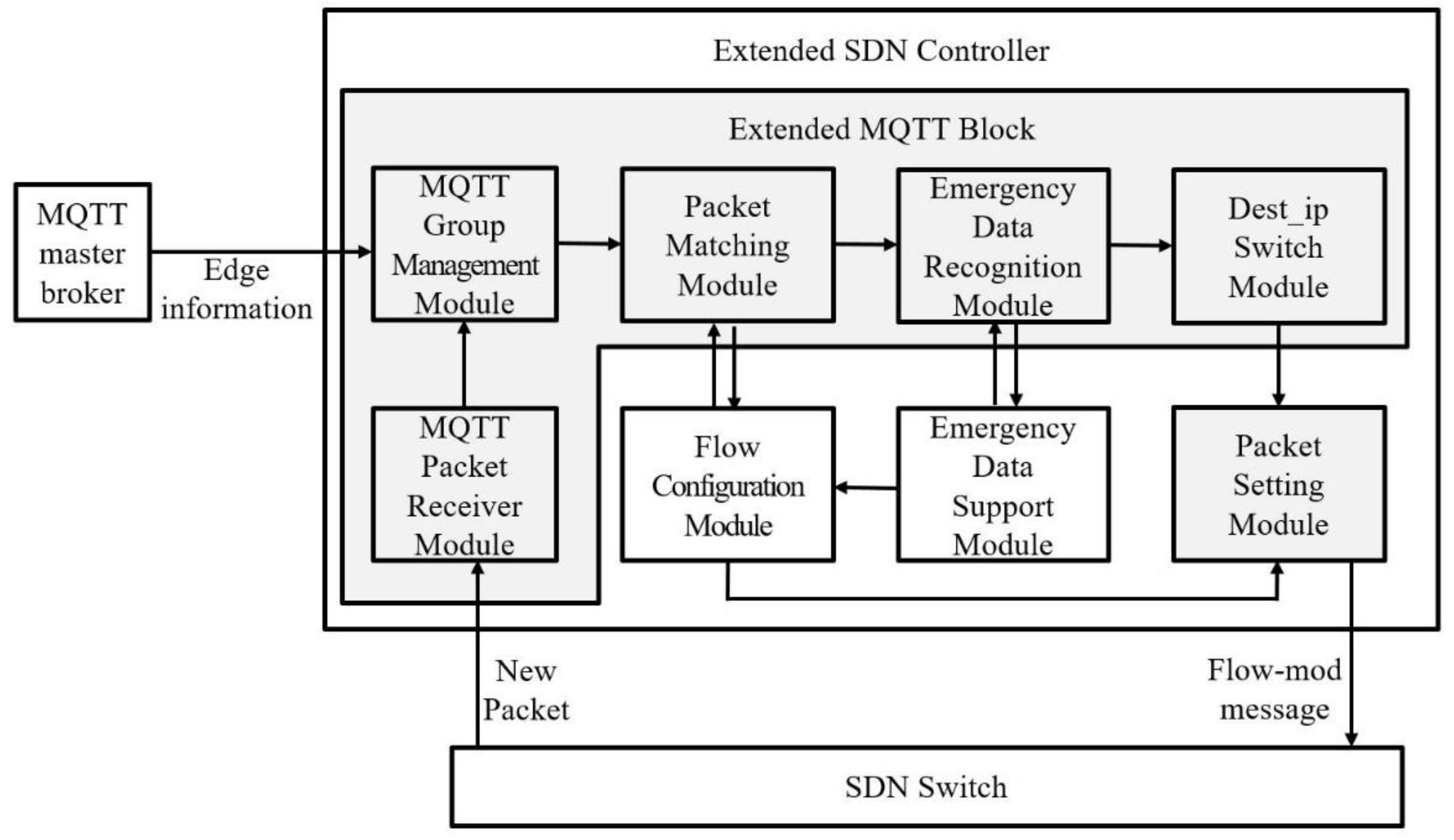
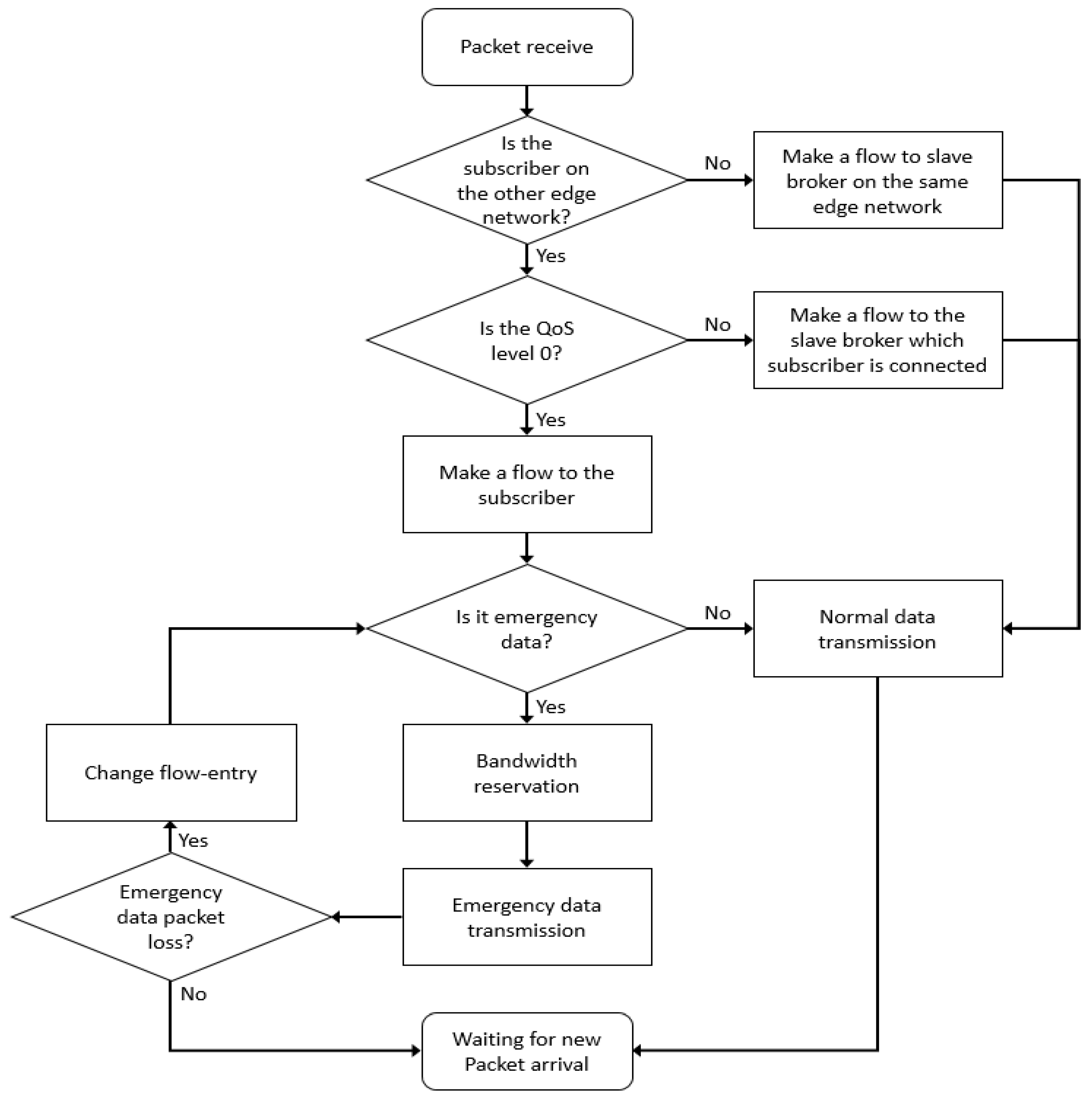
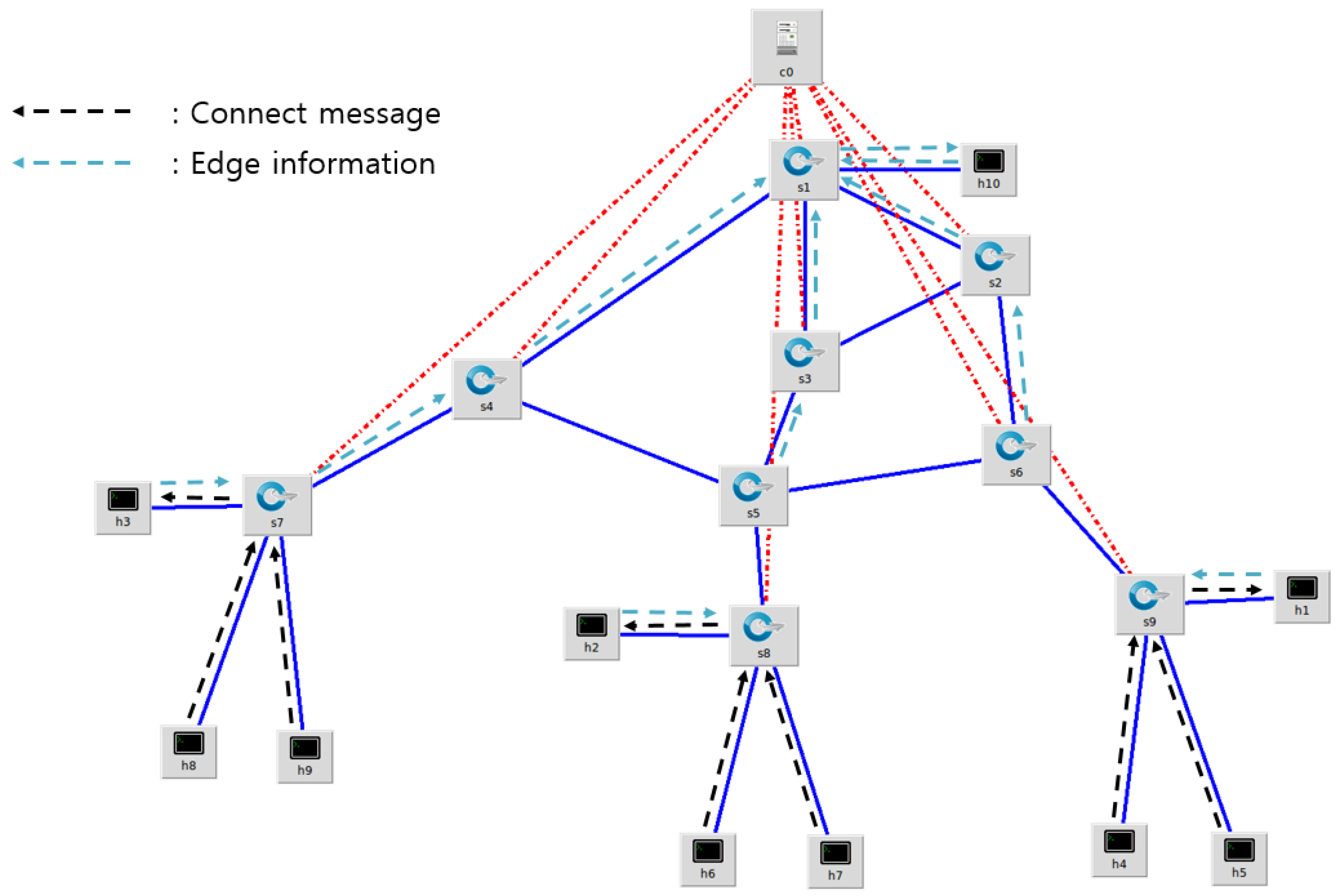
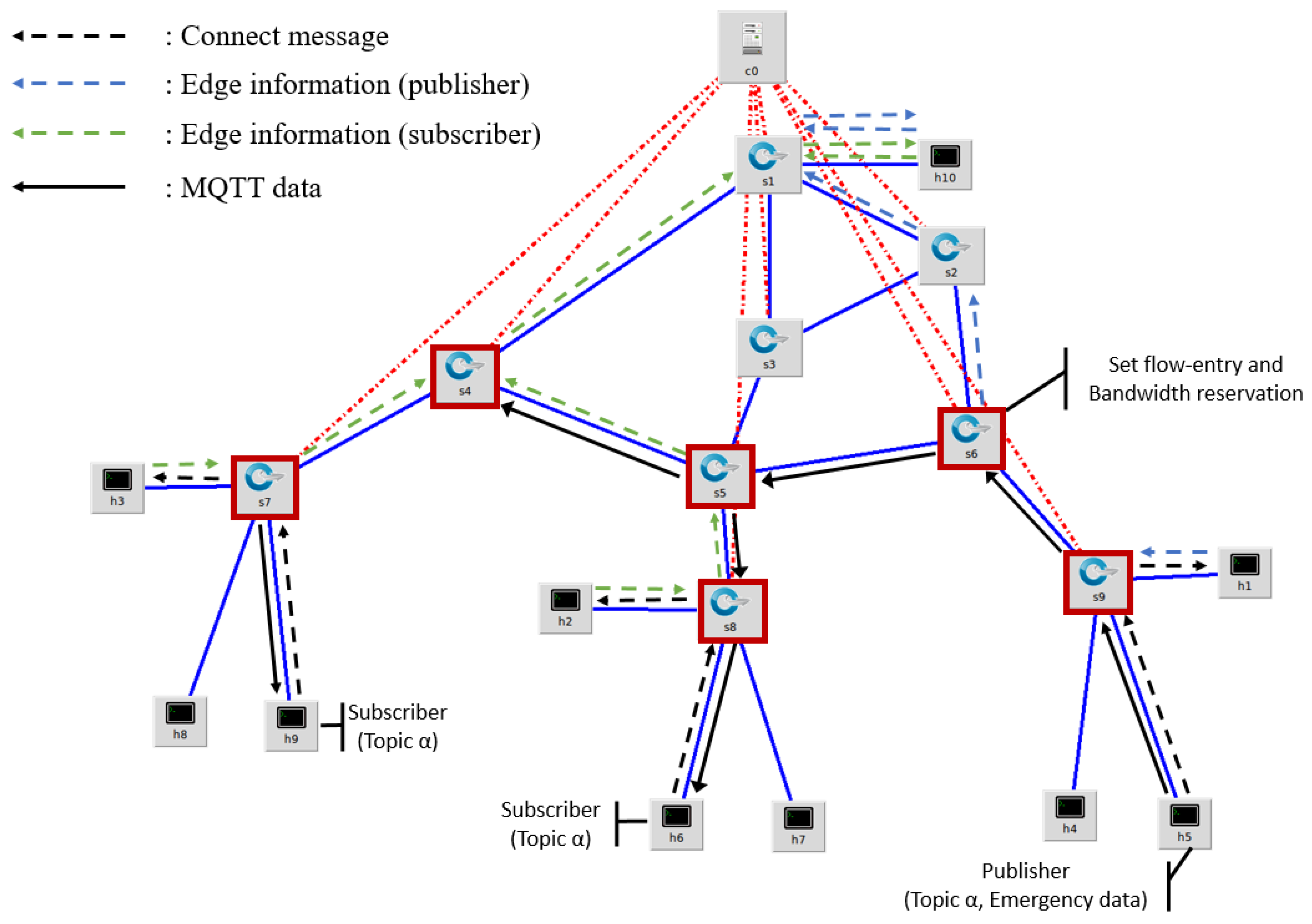
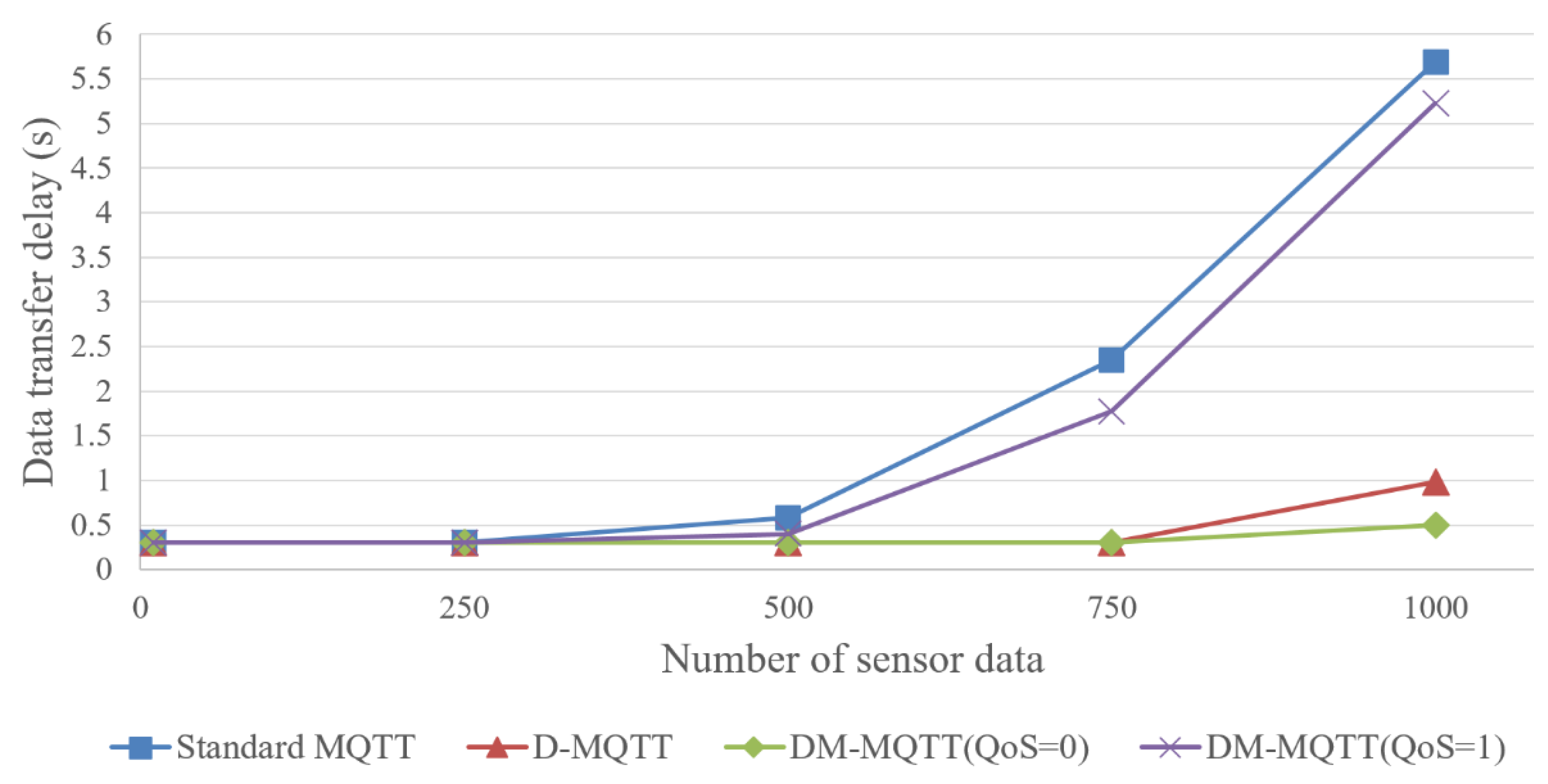
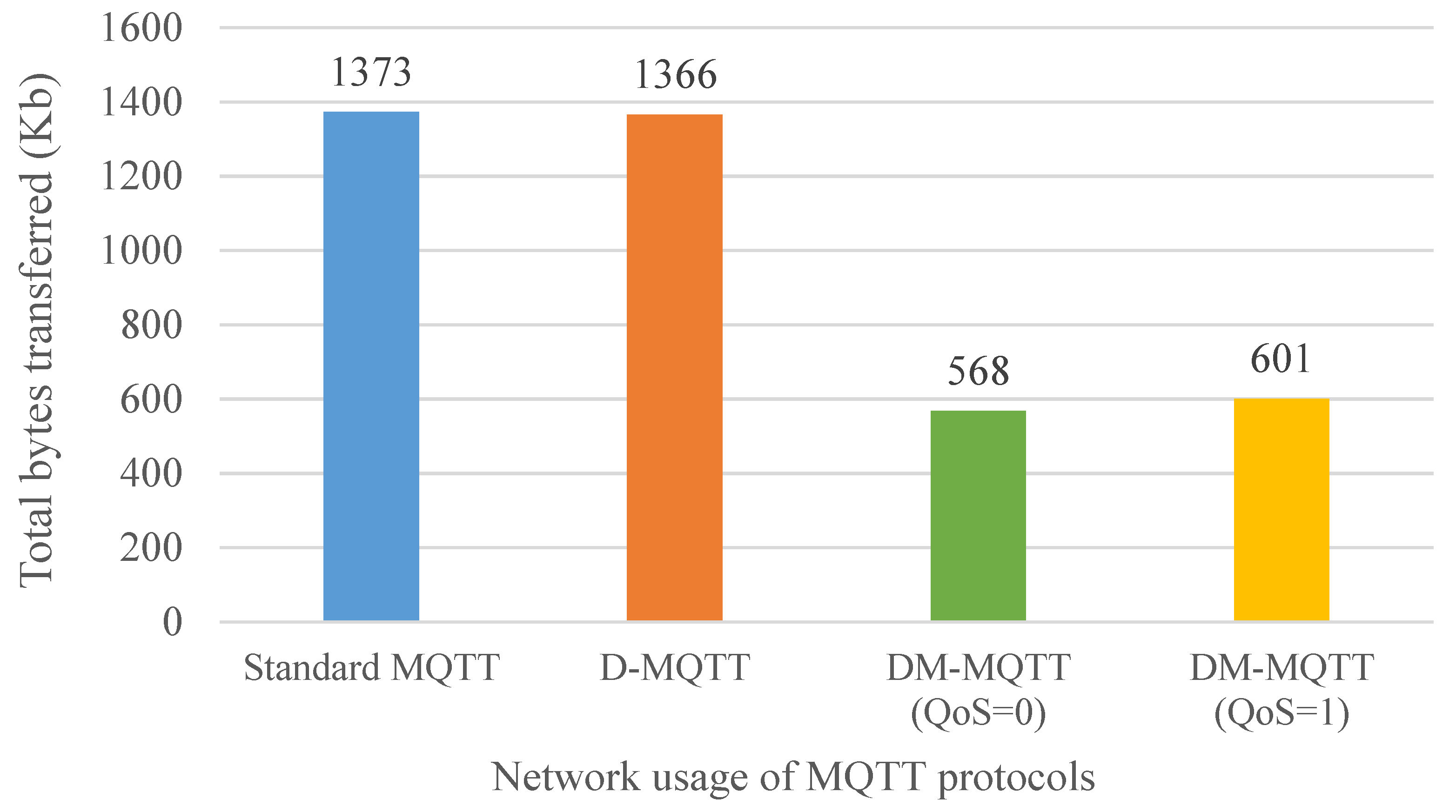
| MQTT | MQTT-SN | CoAP | DDS | |
|---|---|---|---|---|
| Data transmission | Broker Pub/Sub | Broker Pub/Sub | RESTful | Pub/Sub |
| QoS | 3 policies | 3 policies | Partial | 22 policies |
| Real-time | Non-real time | Non-real time | Non-real time | Soft real time |
| Multicast support | Non | Support | Support | Support |
| Transport Protocol | TCP (Transmission Control Protocol) | UDP | UDP | UDP |
| Publisher IP | Pub_slave Broker IP | Subscriber IP | Sub_slave Broker IP | Topic | QoS Level | Multicast Group |
|---|---|---|---|---|---|---|
| 10.0.0.1 | 10.0.0.2 | - | - | temperature | 0 | |
| - | - | 10.0.0.5 | 10.0.0.6 | temperature | 0 | A |
| - | - | 10.0.0.10 | 10.0.0.11 | temperature | 0 | A |
© 2018 by the authors. Licensee MDPI, Basel, Switzerland. This article is an open access article distributed under the terms and conditions of the Creative Commons Attribution (CC BY) license (http://creativecommons.org/licenses/by/4.0/).
Share and Cite
Park, J.-H.; Kim, H.-S.; Kim, W.-T. DM-MQTT: An Efficient MQTT Based on SDN Multicast for Massive IoT Communications. Sensors 2018, 18, 3071. https://doi.org/10.3390/s18093071
Park J-H, Kim H-S, Kim W-T. DM-MQTT: An Efficient MQTT Based on SDN Multicast for Massive IoT Communications. Sensors. 2018; 18(9):3071. https://doi.org/10.3390/s18093071
Chicago/Turabian StylePark, Jun-Hong, Hyeong-Su Kim, and Won-Tae Kim. 2018. "DM-MQTT: An Efficient MQTT Based on SDN Multicast for Massive IoT Communications" Sensors 18, no. 9: 3071. https://doi.org/10.3390/s18093071





